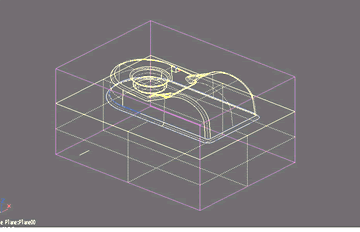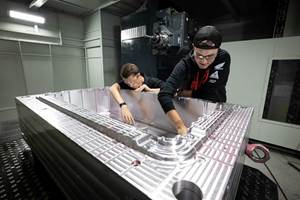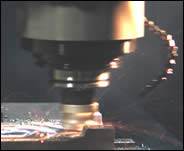The Keys to Successful High-Speed Machining
Moldmakers will reap all the benefits of high-speed machining with the right mix of machine tool, tooling and programming.
Successful high-speed machining boils down to three key elements: (1) machine tool, (2) tooling and (3) programming. The right combination of the three gives moldmaking shops an edge over their competition in regard to productivity, quality and price. The wrong combination wastes your hard-earned money.
Obviously, selecting the right machine tool is essential to optimizing high-speed, near-net machining. Therefore, it’s important to seek out machines specifically designed for high-speed operations. Don’t be lured by standard machine tools modified with high-speed options. Otherwise, you won’t get the rigidity, accuracy and speed necessary to carry out your toughest jobs.
1. Machine Tool
Look for machine tools with rigid structures that dampen vibration, provide stiffness and resist flexing even under high acceleration rates. Machines with heavily ribbed, cast iron construction perfected through finite-element analysis provide the best tool life and surface finishes. In addition, pay close attention to a machine’s slides, way systems, ballscrews and counterbalancing.
While the machine itself should be heavy, moving parts on it should be as lightweight as possible without sacrificing rigidity. Lightweight and stiff slides permit the fastest acceleration rates and reduce total cut time.
As for way systems, your application determines whether or not to use machines with box ways or linear ways. Linear ways are well-suited for small to medium-sized machines with low-torque spindles. And medium to large HSM machines with high-torque spindles call for box ways. While either system works with high-rpm spindle machines that make light cuts at blindingly fast speeds, box ways do have an advantage in vibration damping.
So which should you choose? The answer may be both. Some builders employ linear ways in the X axis and box ways in the Y and Z. The linear ways bear the weight of the table load. This minimizes axis inertia even under widely variable table loads. With a box way system, the amount of torque needed to move the table and overcome stick-slip becomes widely variable and hard to tune.
One of the most important structural elements of any machine tool—but often overlooked—are the ballscrews. You want large-diameter, beefy ballscrews that prevent flex and vibration. Flimsy, lightweight ballscrews simply won’t get the job done. Ensure you get a machine with pretensioned ballscrews (stretched under load) to remove thermal deformation, eliminate growth and promote axis rigidity. If a machine structure can’t support pretensioned ballscrews, the ballscrews must be cooled by a circulating fluid, which, in turn, creates maintenance issues.
A machine without pretensioned ballscrews must have scales for accuracy, but may still lack axis rigidity. Long-travel machines with long ballscrews should have fixed screw/rotating-nut arrangements to prevent screw whip, and servomotors should be directly coupled to ballscrews with a rigid coupling. Servomotors not directly coupled (for example, using pulleys and a belt) suffer from lost motion and lost rigidity, which, ultimately, sacrifice accuracy and finish.
Because of the high acceleration rates in HSM, counterbalancing with counterweights is not feasible. Therefore, you’ll want a machine using a large servomotor with no counterbalance or a hydraulic-counterbalance system (see Machine Design: The Double-Column Advantage Sidebar below and Match Controls, Motors and Drives Sidebar).
Spindles are the heart of any machine tool. While there are a number of spindle types available, including gear box and direct drive spindles, your best bet for HSM applications is the integral or motorized spindle, which produces the highest rpm. A good rule of thumb is to look for machines with spindles that deliver speeds from 15,000 to 40,000 rpm.
Integral spindles combine the motor and spindle—essentially, the spindle shaft is the rotor and the spindle housing is the stator. They’re ideal when you require high speeds and fine finishes.
Although integral spindles can be expensive with high repair costs, they deliver excellent thermal stability with little deformation, exceptional acceleration/deceleration and adequate cutting torque. All these are critical in HSM applications.
2. HSK Tooling
Tooling is the second key to successful HSM. Invest in HSK toolholders, which are superior to CAT/BT and MCAT/BBT systems in terms of rigidity and speed. Don’t be tempted to buy cheaper tooling. In the long run, you’ll only end up costing yourself and you’ll never reap all the benefits of your HSM machine.
What’s wrong with CAT/BT systems? They don’t hold up well under high rpm. That’s because they depend only on spindle-taper contact for rigidity. As spindle speeds increase, centrifugal force can open their pull-stud holding systems.
At high speeds, spindle mouths expand slightly due to centrifugal force, causing conventional toolholders to move further into the spindle because of constant drawbar pulling pressure. This cutter pull-back changes Z-axis dimensional accuracy and can cause tools to stick in the spindle.
So why not MCAT/BBT systems? They improve rigidity because of dual contact between the machine spindle face and the toolholder-flange face, as well as contact with the spindle taper. This contact reduces machine vibration at high speeds and fretting corrosion between the machine spindle and toolholder tapers. However, MCAT/BBT tooling has the same pull-stud-holding arrangement as CAT/BT systems and runs into the same problems with centrifugal force.
Unlike conventional shanks, HSK shanks are hollow, and their clamping mechanisms operate from the inside, making the holders impervious to centrifugal forces. Also, because of HSK short tapers, spindle bearings are placed closer to the spindle nose for improved rigidity.
It’s a good idea to work with your suppliers to select the best HSK system for your HSM machine and applications. HSK-A systems are ideal for high-torque cutting at speeds to 24,000 rpm. HSK-E holders, on the other hand, do not have the drive slots of A-type systems and thereby improve balance at high speeds. This type is great for low-torque finishing operations at high spindle speeds.
A general rule of thumb is to use large HSK-100A for heavy cutting at speeds to 15,000 rpm, medium-sized HSK-63A for medium to fine cutting at speeds to 24,000 rpm and small HSK-50E holders for high-speed finishing.
3. Programming
So you have the best HSM machine tool and are using HSK tooling. But you’re still not getting the results you want. Have you overlooked programming?
It’s a common mistake to apply the same programming software and methods used for conventional machining to HSM work. But you’ll get superior part quality and better overall results using software optimized for HSM. You’ll also get consistent results in unattended operation—machining a part from start to finish with multiple tools without interruption. In addition, you’ll go from rough to semi finish machining without intermediate cutting if your programming software accurately recognizes remaining stock from previous operations.
Today’s advanced CAM systems have several features that are musts for successful HSM. Of utmost importance is having software that cuts true to the surface data. Many systems lay a triangulated mesh over the surface to create the machining program. Unfortunately, all of these tiny triangles laid on the surface are not true surface data, and, ultimately, this type of software will compromise surface finish and accuracy during machining. Other key CAM features to look for include trochoidal roughing routines, Z-level offset machining, and automatic stock recognition and re-machining.
Finding the Right Package and Partner
The right machine is the foundation to successful high-speed machining. Therefore, seek out machine tools with extremely rigid structures that damp vibration, advanced motion systems optimized for HSM and high-speed spindles that can handle your toughest jobs. Then build on that strong foundation with the right tooling and programming.
One final recommendation—ask your machine tool suppliers to help optimize your processes. They can help you engineer a solution that delivers outstanding and consistent results for your HSM applications. Remember, the right combination of machine, tooling and programming will lead to successful high-speed machining and guarantee a competitive advantage for your shop.
Related Content
Developments in High-Speed Machining Technology
There have been many exciting developments in high-speed machining relative to machining centers and controls, tooling and CAD/CAM systems.
Read MoreHow to Eliminate Chatter
Here are techniques commonly used to combat chatter and guidelines to establish a foundation for optimizing the moldmaking process.
Read MoreHybrid Milling/Drilling Machine Reduces Total Mold Machining Time
MSI Mold Builders now squares, plus drills and taps eye-bolt holes on 50% of its tools in a single setup using a five-axis milling/drilling center with a universal spindle.
Read MoreThe Trifecta of Competitive Toolmaking
Process, technology and people form the foundations of the business philosophy in place at Eifel Mold & Engineering.
Read MoreRead Next
Making Sense out of Machine Tool Specifications
Are you doing an accurate comparison when you’re evaluating machine tools?
Read MoreReasons to Use Fiber Lasers for Mold Cleaning
Fiber lasers offer a simplicity, speed, control and portability, minimizing mold cleaning risks.
Read MoreHow to Use Continuing Education to Remain Competitive in Moldmaking
Continued training helps moldmakers make tooling decisions and properly use the latest cutting tool to efficiently machine high-quality molds.
Read More

















.jpg;maxWidth=300;quality=90)













